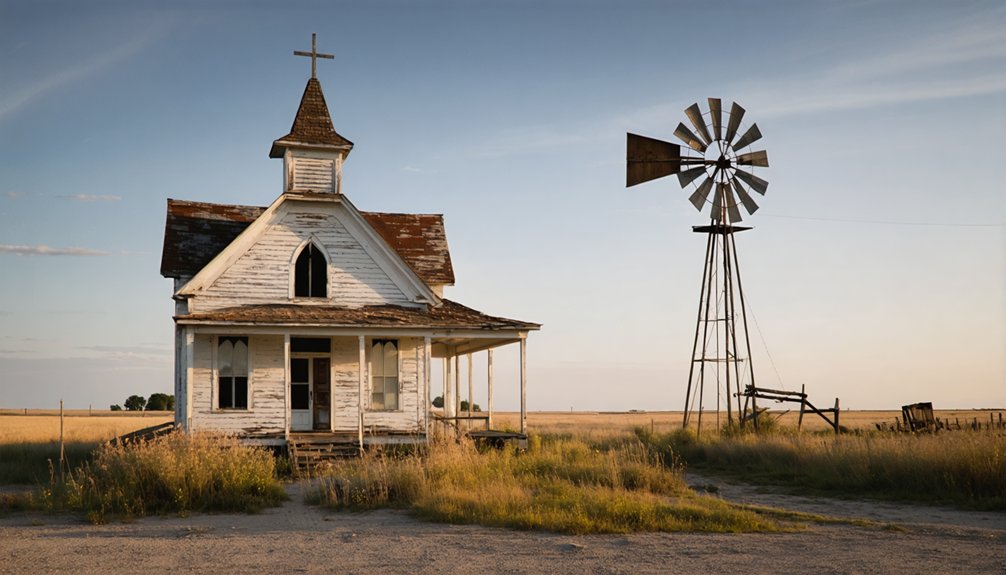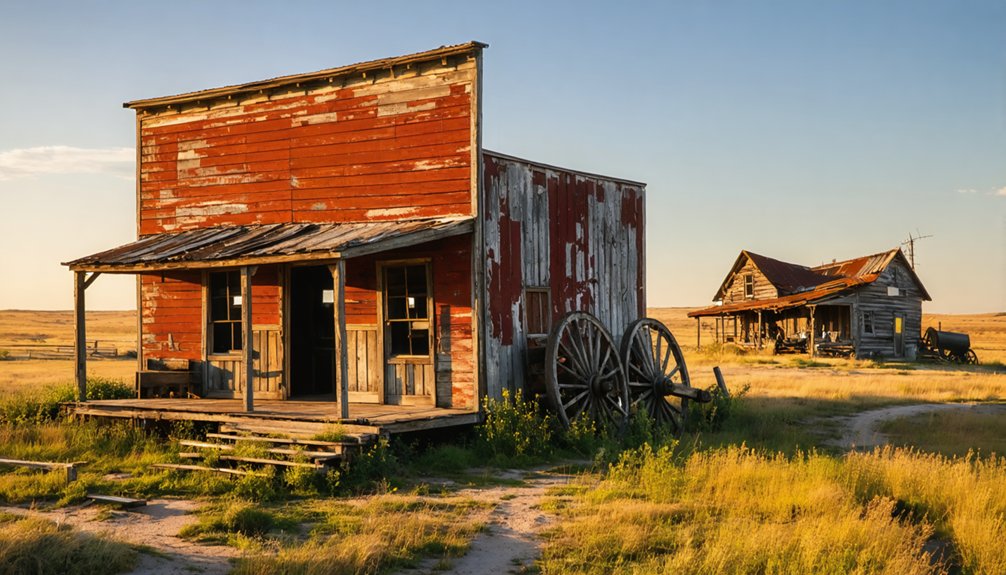You’ll find Castleton’s remains near Hill City in South Dakota’s Black Hills, where gold was discovered in 1875 along Castle Creek. The town quickly grew to 250 residents, featuring saloons, hotels, and even a jewelry store during its peak mining years. Later, it transformed into a railroad hub with the Milwaukee Railway’s arrival, though both mining and rail operations eventually faded. The site’s dredge ponds and building foundations now tell a fascinating tale of boom-and-bust frontier life.
Key Takeaways
- Castleton was established in 1875 following gold discovery in the Black Hills, reaching a peak population of 250 during the mining boom.
- The town transitioned from mining to become a railroad hub when the Milwaukee Railway established operations in the 1880s.
- Located near Hill City, South Dakota, Castleton’s remains include original buildings, foundations, waste piles, and evidence of dredging operations.
- The community featured saloons, hotels, a grocery store, and a jewelry store before declining due to changes in mining technology.
- Castleton followed the typical boom-bust pattern of mining towns, eventually becoming abandoned with only ranch land remaining by mid-20th century.
Origins and Gold Discovery
While the Black Hills of South Dakota became famous for numerous gold discoveries in the 1870s, Castleton’s story began specifically in 1875 when prospectors struck gold in its valley. This discovery came just one year after the Custer Expedition sparked the region’s legendary gold rush, drawing thousands of fortune seekers to the area. Free milling techniques were commonly employed by miners to process and extract the valuable gold deposits.
You’ll find Castleton nestled in the heart of the Black Hills, where early miners used basic techniques like panning and sluicing to extract gold from local streams. The Fort Laramie Treaty had originally promised these lands to the Sioux tribes before the rush of miners violated the agreement.
The town quickly grew to support about 250 residents at its peak, as prospectors flocked to try their luck. The settlement emerged during a transformative period in Dakota Territory history, when neighboring boomtowns like Deadwood and Lead were also establishing themselves as mining powerhouses.
Mining Camp Development
The gold discovery near Castle Creek sparked rapid development of Castleton’s mining operations, though early prospectors soon encountered significant challenges.
You’ll find the evolution of mining techniques reflected the determination of settlers to overcome difficult terrain and complex ore deposits.
- Initial placer mining efforts along Castle Creek proved disappointing, with gold buried too deep in slate deposits.
- Hard rock mining took over, requiring vertical shafts where ore veins changed direction underground.
- The 1900s brought dredging technology, with large floating machines working the river bars.
- Local mills, like the Gold Mountain Mill’s 25-ton daily capacity, processed increasingly complex ores.
The camp grew to support about 250 residents, with infrastructure developing around mining cycles and railroad construction. General Custer first named the area Castle Creek during his 1874 expedition. Similar to other Black Hills ghost towns, Castleton’s population dwindled as mining prospects faded.
Economic challenges ultimately shaped Castleton’s destiny, as mining viability struggled despite multiple boom periods.
Railroad Revival and Transformation
As Castleton’s mining prospects waned in the 1880s, you’d find the town transforming into a crucial railroad construction and transport hub along the Milwaukee Railway’s expanding network.
The railway’s strategic placement of tracks and facilities brought new economic life to Castleton, establishing it as a key transit point for regional commerce and communication. Like many towns of that era, local speculators invested heavily in anticipation of the railroad’s arrival and potential growth. Following common railroad town design principles, Castleton adopted a T-shaped layout with its main commercial avenue perpendicular to the tracks.
You’ll see how the town’s rail infrastructure included essential facilities like grain elevators and warehouses along the sidings, serving the surrounding agricultural communities.
Railroad Construction Impact
During the 1890s, Castleton experienced a remarkable revival through railroad development, transforming from a struggling mining settlement into a bustling railroad town. The introduction of railroad logistics sparked temporary economic growth as crews established the town while pushing northward toward Deadwood. The standard gauge railroad finally reached the area in 1885, marking a significant turning point for the region’s development.
You’ll find these key impacts of railroad construction in Castleton:
- Enhanced mining operations through efficient transport of heavy machinery and dredging equipment
- Improved freight movement that outperformed traditional wagons and stagecoaches
- Creation of temporary workforce communities that supported ongoing rail expansion
- Development of interconnected regional economies replacing isolated mining camps
The railroad’s presence helped overcome Castleton’s challenging geology, particularly benefiting placer operations along Castle Creek.
This transformation reflected a broader shift in the Black Hills region, where rail infrastructure revolutionized both mining and transportation capabilities.
Transportation Hub Development
Once railroad companies established their presence in Castleton, strategic land acquisition and speculation transformed the settlement into an essential transportation hub.
You’d have found the depot serving multiple roles – handling telegrams, mail services, and freight shipments that connected the town to distant markets.
The economic significance of Castleton’s rail facilities became evident as grain elevators and warehouses sprouted along the sidings.
This transportation evolution attracted businesses and settlers, making the depot the heart of local commerce.
You could see the town’s growth directly tied to these rail connections, which overcame geographic isolation and provided crucial links to regional trade networks.
The hub’s strategic importance made it a focal point for investors and railroad executives who shaped the area’s development through careful land acquisition and infrastructure planning.
Physical Geography and Remnants
Located in the picturesque Black Hills of South Dakota, Castleton’s remnants lie scattered along Castle Creek near Hill City at coordinates 44°3’44″N, 103°39’22″W.
The landscape features include meadows and rolling hills, with Castle Creek cutting through terrain that once promised rich gold deposits in its deep, slatey placers. Early settlers were drawn to the area for its prosperous mining opportunities. Castleton experienced its greatest activity in 1876 boom times, when placer mining operations first began.
You’ll find several mining remnants across the site:
- A few original buildings still standing against the test of time
- Visible foundations and waste piles from mining operations
- Evidence of dredging activities along Castle Creek’s bed
- Mining infrastructure ruins scattered throughout the area
While less preserved than other Black Hills ghost towns, Castleton’s physical remnants tell the story of ambitious mining ventures that ultimately failed when gold proved too difficult to extract from the creek’s depths.
Community Life and Demographics

Castleton’s population experienced dramatic swings tied to mining booms and railroad construction, peaking at around 250 residents during its most active period.
You’ll find that the community consisted primarily of male miners and railroad workers, with few families putting down permanent roots in the area.
The town’s social fabric centered around practical amenities like saloons, a hotel, and a grocery store, though it lacked formal civic institutions that might’ve helped sustain a more stable population. A unique aspect of Castleton’s business district was its inclusion of a jewelry store, indicating some degree of local prosperity during the town’s heyday.
Population Fluctuations Over Time
When placer mining operations began in 1876, an initial wave of prospectors and workers swelled the population of this Black Hills settlement to around 200 residents.
The population dynamics of Castleton followed the boom-bust pattern typical of mining towns in the region, with demographic trends closely tied to resource extraction and railroad development.
- Railroad construction in the 1890s brought temporary population surges as crews pushed north toward Deadwood.
- Mining dredge operations in the early 1900s sparked a brief revival in both economic activity and resident numbers.
- The workforce remained mainly male throughout the town’s active years.
- By the mid-20th century, the population had dwindled to just a handful of residents, with the area primarily serving as ranch land.
Social Structure and Organization
As mining operations flourished in Castleton during its peak, the town developed a distinct social hierarchy centered around its 250 residents and various community establishments.
You’d find mine owners and business proprietors at the top, while laborers formed the working-class majority. The town’s community dynamics revolved around social networks formed in saloons, the hotel, and local shops.
The population skewed heavily male, with most residents being single miners or mining families. Women played essential roles running boarding houses and shops that kept the town functioning.
While you’d encounter some ethnic diversity among European immigrants, the social structure remained focused on mining-related activities. The transient nature of mining work meant that social bonds were often temporary, with residents moving as employment opportunities shifted.
Historical Impact and Present Day
Through its evolution from mining camp to railroad hub, Castleton left an indelible mark on Lawrence County’s development in the late 19th century.
You’ll find its legacy woven into the cultural heritage of the Black Hills, where economic shifts shaped the rise and fall of numerous mining communities.
- The town’s strategic location supported essential mining operations and railroad construction, contributing to the region’s growth during the gold rush era.
- You can trace Castleton’s economic impact through its diverse businesses, from hotels to jewelry stores.
- Today, you’ll discover historical markers and dredge ponds that tell the story of this once-bustling community.
- The town’s transformation into a ghost town mirrors broader changes in transportation and mining technology that reshaped the Black Hills landscape.
Frequently Asked Questions
Were There Any Notable Crimes or Lawlessness Incidents in Castleton’s History?
You won’t find documented crime stories from Castleton’s brief existence. While the broader Black Hills had its share of lawlessness, local law enforcement records don’t highlight any notable incidents in this railroad town.
What Happened to the Mining Equipment and Machinery After the Town’s Abandonment?
You’ll find most mining equipment was left to decay onsite, with some machinery salvaged by locals. Large items like dredges remained abandoned, while valuable metal parts entered the secondhand market or became scrap.
Did Any Famous Historical Figures Ever Visit or Stay in Castleton?
While you might wish for tales of famous visitors, there’s no historical evidence that any nationally known figures ever stayed in Castleton during its brief period of regional significance as a mining camp.
Were There Any Significant Native American Interactions With Early Castleton Settlers?
You’ll find limited records of native treaties or cultural exchanges in Castleton specifically, though the area’s Sioux tribes likely interacted with settlers through trading and occasional territorial disputes.
What Was the Average Gold Yield per Month During Peak Mining Operations?
During peak mining operations, you’d see gold production averaging 8,900-9,200 ounces monthly at Wharf Mine, generating about $2.5 million in value during the late 1990s at $279 per ounce.
References
- https://www.sdpb.org/rural-life-and-history/2023-08-21/some-black-hills-ghost-towns-and-their-origins
- https://www.blackhillshikingbikingandmore.com/castleton
- https://en.wikipedia.org/wiki/List_of_ghost_towns_in_South_Dakota
- https://freepages.history.rootsweb.com/~gtusa/usa/sd/blackhills.htm
- https://www.blackhillshikingbikingandmore.com/old-mining-ghost-towns
- https://www.hmdb.org/m.asp?m=184801
- https://explore.digitalsd.org/digital/collection/WPGhosttown/id/1332/
- https://freepages.history.rootsweb.com/~gtusa/usa/sd.htm
- https://en.wikipedia.org/wiki/Black_Hills_gold_rush
- https://www.ebsco.com/research-starters/history/black-hills-gold-rush



